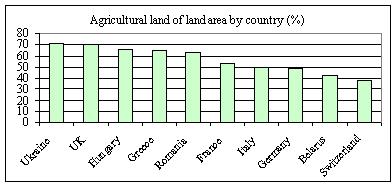Назад в библиотеку
Necessity of Growth of Agriculture Protection in Ukraine
Автор: Новикова Е.В.
Научный руководитель: Гизатулин А.М.
Источник: Сучасна інформаційна Україна: інформатика, економіка, філософія / Матерiали IV мiжнародної науково-практичної конференцiї молодих учених, аспірантів, студентiв — Донецьк, Державний університет інформатики і штучного інтелекту — 2010, Том 2, с. 116-120.
Аннотация
Новикова Е.В. Necessity of Growth of Agriculture Protection in Ukraine. В данной работе показана важность сельского хозяйства как субъекта хозяйствования в европейских странах и в Украине, описаны основные способы защиты сельского хозяйства.
Currency
The collapse of the Doha trade negotiations in the summer of 2008, again, put the spotlight on two important realities of international trade policy. The first is that, despite the strong decline of agriculture in terms of employment and output in rich countries, agriculture remains disproportionately important to rich countries in their trade negotiations – even to the extent that they are willing to let the WTO negotiations collapse over disputes on agricultural policy. The second reality is that despite hundreds of years of economists’ arguing the optimality of free trade, political factors are more important than these economic arguments in both rich and poor countries. The political economy of agricultural policy is crucial to understanding the positions of the developing and developed countries in their trade negotiations, as well as their apparent inability to reform unilaterally or to reform as part of a broader trade negotiation outcome.
Europe is a fascinating case for the study of growth in agricultural protection because it has gone from one extreme to another in the course of one century.
Goal of research
To show the importance of agricultural as a subject of economic management in European countries and in Ukraine; describe the main ways of agricultural protection.
Main part
Historically Ukraine was the agro industrial country. The agricultural sector produces 12,8% of GDP, employing a fifth of the working population.
The soil of chernozem (humus) which occupies 60 % of the Ukrainian land is natural riches of Ukraine. Besides, Ukrainian has the biggest part of agricultural land (above 70%) in Europe (look at the picture 1). More than 40 % of all agricultural products of Ukraine are grown up without use of pesticides, as a result of it the Ukrainian meal is the most natural and safe in Europe. This accounts for the high potential of agricultural production.
Picture 1. Agricultural land of land area by country in a %
Among all European countries Ukraine is the leader on cultivation of a sugar beet, buckwheat groats and carrots; it takes the second place on cultivation of wheat and tomatoes. 28 % of all population of Ukraine works in agriculture sector. After disintegration of the USSR in Ukraine there were farms and house economy. The quantity of farms therefore productivity has increased every year.
From 60 million hectares of the earth approximately 42 million technical grain crops, fodder, vegetables, gardens, vineyards, and constant meadows and pastures are classified as an arable land which includes the processed earth under grain crops.
In 1998 the considerable quantity of sugar, beef, a sunflower, and fish has been exported. The total cost of agricultural export has been estimated in $1 898 000 000. The biggest crop of a potato was in 1999, it has made 15.4 million tons. Last few years the agricultural production has decreased because of reduction among tractors and combines.
For today Ukraine is in a stage of structural decomposition that is reflected in production efficiency decrease, work decline of productivity. Reforms which occur for the last few years in an agro-industrial complex have not helped to meet crisis. As a result of the enterprise cannot carry out the activity effectively. The growth rate in agriculture was only 55% in 2009 (look at the picture 2). It is very low level among European countries. This result was 141 of 147 world countries.
Picture 2. Agricultural growth by country in %
Many economy which have no enough money to buy the new technics, use old machines with low productivity. These machines pollute environment much more, than new. The biggest problem of agriculture in Ukraine is irrational use of the ground areas. Therefore the agriculture of Ukraine is characterised as unstable. The one of existing ways of overcoming this problem is the development of agriculture protection.
In a recent review of the literature on the political economy of agricultural protection, Swinnen (2009) highlights three sets of variables that have been identified as important causes of agricultural protection in the literature:
- comparative advantage and market fluctuations which affect market returns and incentives to demand government protection from market forces;
- the structure of the economy – which is typically affected by economic development and which affects both the costs of distribution and the ability to organise politically;
- political institutions and organisations.
Factors that appear to have played an important role in causing the increase in agricultural protection in Europe are:
- the decline of income from markets for farmers, in particular in comparison with incomes from the rest of the economy;
- the reduced share of consumer expenditures for food;
- the farm structure;
- the political organisation of farmers and the growth in government administrative capacity for regulating markets;
- the food shortages during the world wars in Europe, and democratisation.
Conclusions
Despite the considerable difficulties and problems that exist today, the industry preserves a significant potential for growth and intensive development and the solution of numerous problems, seems to be found in the development of an integrated system of construction and modernization of agro-industrial complex.
Literature
1. Swinnen, J. (1994), ‘A Positive Theory of Agricultural Protection’ American Journal of Agricultural Economics, 76, 1-14.
2. Swinnen, J. (2009), ‘The Political Economy of Agricultural Policies.’ Agricultural Economics, 26, 25-43.
3. http://www.nationmaster.com/

